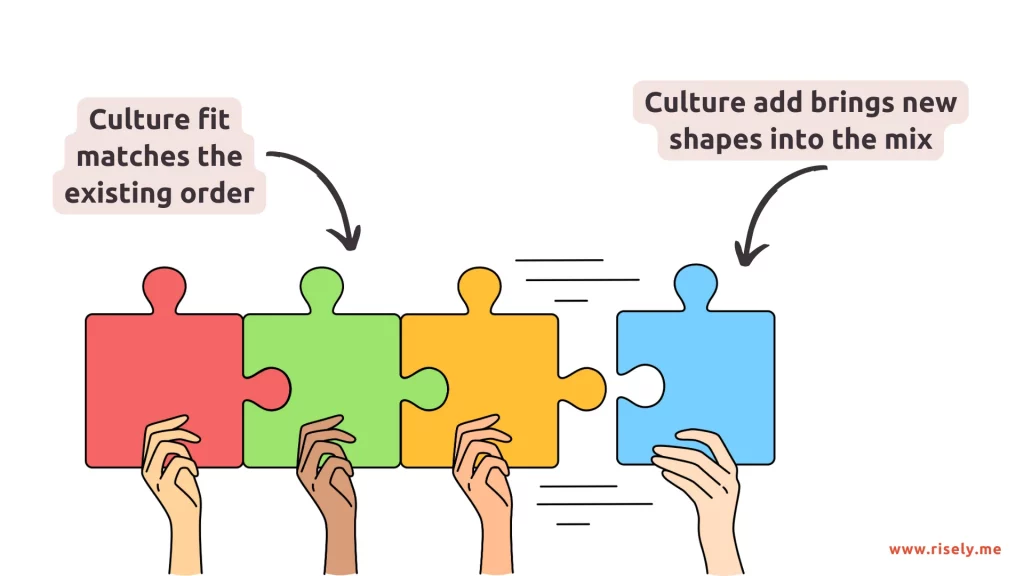Culture Add Vs Culture Fit: Which One Is Good For You
When it comes to recruitment strategies, two terms that often arise are Culture Fit and Culture Add. These concepts play a significant role in shaping a company’s workforce and organizational culture. Understanding the nuances between Culture Fit and Culture Add can help you make informed decisions when it comes to hiring practices. Let’s unravel what this is all about!What is Culture Fit?
Culture Fit in the context of recruitment refers to the alignment between a job candidate and the existing company culture. It involves assessing whether a candidate’s values, interests, and work preferences resonate with those of your team. The hiring process based on Culture Fit aims to ensure that new hires seamlessly integrate into your company’s work environment.How did culture fit hiring come about?
The concept of Culture Fit hiring emerged from the need for organizations to maintain a cohesive work environment by hiring individuals who align with their organizational values. It became a common practice in hiring to ensure that new employees could easily adapt to the company’s culture and contribute positively to the team dynamics.What Pros and Cons of Hiring for Culture Fit You Must Know?
Why is culture fit good?
- Culture-fit employees are more likely to stay with your team for a longer duration, reducing turnover costs.
- Hiring for Culture Fit help you with quicker integration into the team and increased productivity.
What can go wrong with culture fit?
- Emphasizing Culture Fit may lead to unconscious biases in your decisions.
- Overreliance on Culture Fit results in a lack of diversity within the organization, limiting innovative ideas and perspectives.
Introducing Culture Add
Contrary to Culture Fit, Culture Add focuses on bringing in individuals who not only align with the company’s values but also bring new perspectives and diverse opinions to the table. This approach emphasizes the value of fostering an inclusive work environment that thrives on different backgrounds and experiences.How Culture Add Diversifies the Workplace?
You can create a diverse workforce that enhances innovation and problem-solving capabilities by prioritizing addition to your culture in the recruitment process. New hires bring unique insights and viewpoints contributing to a more inclusive and dynamic workplace culture.Why should you embrace culture add in your team?
- Embracing this approach fosters a company culture that values diversity and inclusion.
- Employees feel engaged and motivated when their contributions are recognized and valued.
- Problem-solving abilities improve as teams benefit from a wide range of perspectives.
Other Interesting Reads
Culture Add Vs Culture Fit: Let’s Compare
At its core, understanding the nuances between Culture Fit and Culture Add can significantly shape your team’s trajectory. Let’s reflect on these concepts and their pivotal role in enhancing company culture and fostering inclusivity. In the early stages, many organizations heavily rely on the idea of Culture Fit. This approach emphasizes hiring individuals who are seamlessly aligned with the existing company culture. Your focus is on ensuring smooth onboarding and immediate integration, where new hires can easily blend into the established norms and values.
How to shift your team from culture fit to culture add?
Moving from a Culture Fit to a Culture Add approach requires a strategic shift in the recruitment process. Here are a few areas where you should act:Start with changing your hiring approach
When shifting towards a Culture Add approach, organizations can implement several strategies to embrace diversity and foster innovation. These include implementing blind resume reviews, conducting diverse interview panels, offering unconscious bias training for your hiring managers, and setting specific diversity goals for recruitment efforts. By actively seeking out individuals who bring different perspectives and experiences, you can benefit from a richer pool of talent and drive long-term success.Implement Culture Add in Your Recruitment Process
Implementing culture Add in your recruitment process involves recognizing the value of diverse perspectives and unique backgrounds within your team. By shifting focus from mere “fit” to “add,” organizations can promote inclusivity, foster innovation, and ultimately drive success. Now, how can you actually do this?- Reinstate what culture and values mean to you. Encouraging a holistic discussion on the topic and further help you spread these ideas in the team
- Partner with diverse job boards, community organizations, and educational institutions to attract talent from various backgrounds
- Write job descriptions that emphasize the importance of diverse experiences and perspectives. Avoid language that might unintentionally exclude certain groups
- Assemble interview panels that reflect a variety of backgrounds and viewpoints. This will help you mitigate biases and ensures a fair evaluation of each candidate’s potential cultural contributions
Measuring the Impact of Culture Add
Assessing the impact of culture Add on an organization involves tracking diversity, employee engagement, and long-term benefits metrics. By evaluating the success of the transition, you can determine the effectiveness of the new hiring approach. When evaluating the success of a culture-add approach, it’s essential to consider personal preferences, as they play a crucial role in determining how an individual integrates into your existing team dynamics. Additionally, assessing whether the new hire brings a fresh perspective or introduces innovative ideas can be a good idea. Different perspectives within the team can lead to enhanced creativity and problem-solving abilities.Long-term Benefits of a Culture Add Approach
Opting for a cultural approach can have several long-term benefits for an organization. Aligning new hires with the company’s core values fosters a sense of belonging and strengthens organizational values. This, in turn, boosts employee engagement and creates a positive work environment. Embracing culture add is indeed a good thing for both the employees and the organization as a whole. You can learn more about this here:Overcoming Challenges in Adopting Culture Add
Successfully transitioning from a culture fit approach to embracing culture add can be met with resistance. Some challenges include:- overcoming unconscious biases
- disrupting the status quo
- integrating diverse opinions into the hiring process
Conclusion
In conclusion, embracing a culture add approach can lead to a more diverse and inclusive workplace environment, fostering creativity and innovation. While culture fit has its advantages, prioritizing culture add can bring about a positive shift in organizational dynamics and employee engagement. Companies can enhance their overall growth and success by focusing on adding value through unique perspectives and experiences. Transitioning from culture fit to culture add requires strategic planning and a commitment to inclusivity. It’s essential to measure the impact of culture add through relevant metrics and reap the long-term benefits of a more dynamic workforce. Overcoming challenges and embedding culture add into company values are crucial steps toward building a resilient and forward-thinking organization.Big changes need great communication.
Assess yourself for free now.
Master the art of effective communication by reviewing your skills with a free assessment now.
Other Related Blogs
Building a Coaching Culture with Jo Wright
Building a Coaching Culture with Jo Wright As AI takes over, we are all searching for the part that makes us truly human. For most managers and leaders, this search…
What’s Culture Add and Culture Fit? | Victor Bullara
What’s Culture Add and Culture Fit? | Victor Bullara Do we hire for culture, or not? This has been a long raging debate. We create our take on this dialogue…
8 Ways To Undo A Toxic Workplace Culture
8 Ways To Undo A Toxic Workplace Culture As per Gallup’s research in Australia, mental health conditions contributed to 9% of all work-related injuries. In another global study, almost one…
How To Build A Learning Culture At Work?
How To Build A Learning Culture At Work? Go back to the beginning of your career. Fresh out of college and looking at the prospect of your new fancy job…


